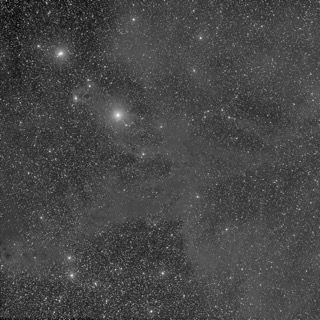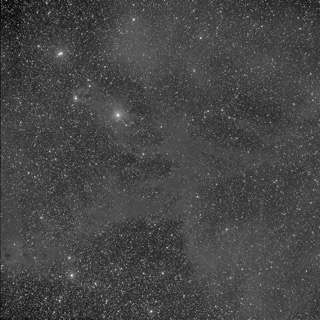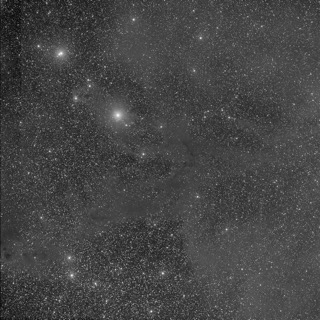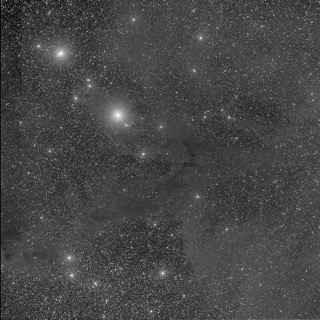Dark Clouds in Chamaeleon and Thumbprint Nebula - Astrophotography
- Antoine & Dalia Grelin
- Nov 25, 2022
- 10 min read
Updated: May 17, 2023
Nebulosity does not always have to be bright and colorful to be beautiful! Some objects, like the dust clouds present in the constellation Chamaeleon, also look impressive despite their lack of color.
The "Dark Clouds" in Chamaeleon are gigantic clouds of space dust that are so thick that they hide the stars behind them.
Object Designation: Cha I, Cha II, Cha III
Also known as: The Chamaeleon Cloud Complex
Constellation: Chamaeleon
Object Type: Nebula
Distance: 629 light-years away
Magnitude: Unknown
Discovery: Unknown
We have imaged a part of Chamaeleon where dust clouds are very prominent, and are known as the Chamaeleon Cloud Complex. Because it is huge, the telescope was aimed at a specific section of this complex, the Cha III section. See our results below!
Chamaeleon Dust Wide-Field Astrophotography with the Takahashi FSQ-106

The constellation Chamaeleon is located in the southern hemisphere, and so it never rises in our Nevada skies.
When we really want to image a target that is impossible to see from our sky, we use Telescope Live which allows us to remotely control a telescope in several different locations in the world.
The telescope setup you see above is the one we used for this object, and is located in Australia! Chamaeleon is visible in Australia for a long period of time, so it is a great target for this remote setup.
The picture below totals 11 hours of exposure time, and was processed using PixInsight.
The Chamaeleon Dust Complex shows an insane amount of IFN. Click for High-resolution.
Want to process your images following our own workflow? Download our PixInsight PDF Guide!
GEAR USED:
Camera: FLI PL16803
Telescope: Takahashi FSQ-106
Mount: Software Bisque Paramount MX+
Processing: Pixinsight
ACQUISITION DETAILS:
Total Exposure Time: 11 hours
Exposure Time per frame: 10 minutes
Filters: LRGB
What is the Chamaeleon Cloud Complex?
The Chamaeleon Cloud Complex is a gigantic star-formation region. It is made up of three main sections:
Chamaeleon I (Cha I)
Chamaeleon II (Cha II)
Chamaeleon III (Cha III)
The main image above shows the Chamaeleon III dark cloud, in the shape of an "A". If you look to the very bottom, a small part of the Chamaeleon II dark cloud is visible. To the left of the image you can spot a section of the Chamaeleon I dark cloud.

Being 600 light-years away, Cha I is one of the closest star-forming regions from Earth. It contains a total of approximately 237 stars. The dust cloud was imaged in 1981 through X-Ray filters and shows the activity within, as you can see on the left.
Chamaeleon II is also active, but much less than Cha I. Only 50 stars have been detected there.
Cha III on the other hand is completely empty of star-forming activity. To our knowledge, there are no new stars being born in this third dust cloud.
Although there are several distinctive shapes within the dust clouds, only one is officially cataloged, the Thumbprint Nebula. It is a small non-star-forming bok globule that resembles a thumbprint in gray ink.
The Thumbprint Nebula can be spotted in our image near the bottom right of the "A" shape. It is circled in orange below. A galaxy can be found nearby, IC 3104, annotated above the brightest blue star.

There are likely a few other galaxies and nebulae visible in the background, but none stick out that much due to their small apparent size. There might also be several objects hidden behind the dark dust clouds.
How to find the Dark Clouds of Chamaeleon in the Sky?
The Chamaeleon Cloud Complex can be found approximately 600 light-years away in the constellation Chamaeleon.
There is no best time to image the Chamaeleon Cloud Complex because it is available all year round! Indeed, the constellation is circumpolar and so never sets for southern observers.
The entire Chamaeleon dust complex can be seen circled on the map below. Cha I, Cha II and Cha III are all in that area of the sky.

The constellation Chamaeleon is located not far from the southern pole. Although it looks like a frying pan, it actually represents a chameleon grabbing a fly with its tongue. 🦎🪰 The fly is represented by the nearby constellation Musca. Other constellations near Chamaeleon include Volans, Apus, and Octans.
Chamaeleon was first drawn in 1603 in the star atlas "Uranometria" by Johann Bayer. The constellation was named by Petrus Plancius, who sent both Pieter Dirkszoon Keyser and Frederick de Houtman to the southern hemisphere in the 16th century to study the location of the stars. You can learn more about this constellation, and the 87 others in our Constellations Handbook.
To find the cloud complex, look for the four bright stars in the constellation forming somewhat of a rectangle shape. The Chamaeleon Cloud Complex is in and around these four stars.
How far is the Chamaeleon Cloud Complex?
A 2018 research by ESO revealed the estimated distance of all three dust clouds in the Chamaeleon Cloud Complex. Previous findings stated that the Chamaeleon clouds were between 160 and 180 parsecs away, but the new research found they were slightly farther than previously thought.

The 14-page paper shows the following distances for each dust cloud:
Chamaeleon I - 179 pc (584 light-years)
Chamaeleon II - 181 pc (590 light-years)
Chamaeleon III - 193 pc (629 light-years)
Chamaeleon III, which is what you see in our image, is the farthest of the three dust clouds. The Chamaeleon Cloud Complex has a total mass of 500 million times the one of the Sun.
The Chamaeleon Cloud Complex by NASA and the Hubble Space Telescope
NASA used the Hubble Space Telescope to capture images of the Chamaeleon Cloud Complex. Because of how big the complex is (65 light-years wide) and how small the field of view of the HST is, the picture you see below only shows a tiny fraction of the object.

This is just one of three sections that make up the star-forming region of the Chamaeleon Cloud Complex.

The image above was taken by the Hubble Space Telescope and was released in 2022. It is 315 million pixels wide and is made up of 23 different observations.
The three segments are Cha I, Cha II, and Cha III, the one you see below is Cha I.
You can see bright young stars reflecting light against the dusty clouds, as well as several Herbig-Haro objects. This is an active star-forming region where colorful light is starting to take over the darkness.
The picture on the right was taken by Gaia, and is a wide field star-density map where you can see Cha I, Cha II, Cha III, and the nearby Musca star popping out.
This other NASA image below was taken almost nine years prior and shows an intriguing new object, a young star propelling light, gas, and other material from each pole. Named HH 909A, this object was just formed as the result of the intense star-forming activity in the area.

The picture above shows an example of a successful star birth, but many other young stars did not have the same luck. It is believed that several of these never reach critical mass to ignite their core enough, and become "failed stars", also known as "brown dwarves".
Our Premium Astrophotography Course
Want to learn all aspects of astrophotography in the most efficient way possible?
The Galactic Course includes a LIFETIME membership that gives you unlimited access to all current and upcoming astrophotography content. Step into an ever-growing realm of knowledge and learn at your own pace. Make life-long friends and connections with other members, and get tips from instructors that truly care about your journey and progress under the night sky.
Recommended Equipment for Astrophotography of the Dust Clouds in Chamaeleon
The dust clouds in the Chamaeleon Cloud Complex are very faint and not easy for beginner astrophotographers.
We recommend using a fast widefield refractor, like the FSQ-106 used in our example. It has a focal length of 382mm, an aperture of 106mm, and a focal ratio of 3.6 when used with the 0.73x reducer.
This telescope is very expensive because it is one of the best in its class, but here is another example of a more affordable telescope with similar specs you can use to capture this object:
Askar FRA 500 with f/3.9 reducer:
Focal Length: 350mm (with reducer)
Aperture: 90mm
Focal Ratio: f/5.6 but f/3.9 with reducer
With the f/3.9 reducer, this telescope gets very close to being as fast as the Takahashi FSQ-106. The main drawback is that the reducer might show some tilt when used with a full-frame camera.
Using a DSLR Camera and Lens for Faint Nebulae
If you are a beginner astrophotographer and do not yet own a German Equatorial mount and astronomy-dedicated camera, you can use a fast lens to image this object. If you own a DSLR camera and a star tracker, we recommend getting the Samyang 135mm f/2, which is a fantastic lens for astrophotography.
It is very fast at f/2 and the corners look flat with most cameras. Try taking 3-6 minute exposures from a dark site (Bortle 1 or Bortle 2) and see if you can reveal some of the dust in the Cloud Complex!
Using Telescope Live to Capture Deep Sky Objects
If, like us, you are sad that you cannot image some lovely targets because they are in the opposite hemisphere, maybe give Telescope Live a try! With Telescope Live, you can easily control a telescope that is on the other side of the world, and take pictures of the target of your choice. You can also download raw data that was previously acquired by other users at a much lower price than reshooting the object.
The data processed in this post was acquired by a high-end telescope setup in Australia, controlled using Telescope Live. The owners decided to give us and our subscribers a discount, which you can use to get started.
You can use the code "TL4GH" when signing up!
Some of the other images we got using Telescope Live include the Bug Nebula, the Tarantula Nebula, and more recently the Great Barred Spiral Galaxy!
Do I Need Filters to Photograph the Chamaeleon Cloud Complex?
The Chamaeleon Cloud Complex is made up of dark clouds of dust, as well as some sections of reflection nebulosity. Because of that, you do not need any narrowband filter to capture this object. A good DSLR or One-Shot-Color camera without filters is recommended to image this part of the sky. If you own a monochrome camera, use the L, R, G, and B filters.

Processing the Chamaeleon Cloud Complex
The Chamaeleon Cloud Complex is a difficult target to process. It is made up of dark space dust, so revealing these dark clouds against the already-dark background can be tricky! Usually, the key for these types of targets is to apply noise reduction a bit more often than usual but also more carefully. It is very easy to bring out a ton of noise when trying to reveal the dark dust, and it is as equally easy to accidentally blur the whole image by applying too much noise reduction.
On top of that, be sure to fully remove the stars early in your processing workflow and to use masks when playing with saturation or detail enhancement.
The main thing is to be careful and not rush when processing dark nebulosity.
Stacked results from each filter, in order L > R > G > B
Overall, I mostly followed our usual PixInsight workflow for this target. If you are interested in learning how I process all our images, you can access our full processing guide HERE.
Chamaeleon Cloud Complex FAQ
In which constellation is the Chamaeleon Cloud Complex located?
You can find the Chamaeleon Cloud Complex in the constellation Chamaeleon.
How big is the Chamaeleon Cloud Complex?
Chamaeleon Cloud Complex spans 65 light-years across.
How far is the Chamaeleon Cloud Complex?
The Chamaeleon Cloud Complex I is located 584 light-years away from Earth, Cha II lies 590 light-years away and Cha III 629 light-years away.
How long should my exposure time be when photographing the Chamaeleon Cloud Complex?
600 seconds (10 minutes) is what we would recommend doing when shooting this object. The faint dark dust clouds are difficult to see and the long exposures will help reveal the data. If you have full trust in your mount and guiding, you can even try 30-minute exposures!
Should I use a filter to image the Chamaeleon Cloud Complex?
The Chamaeleon Cloud Complex is a broadband target, so you do not need any filter. It is best imaged with a DSLR or OSC camera, or a monochrome camera using LRGB filters.
What equipment do I need to photograph the Chamaeleon Cloud Complex?
A tracker or equatorial mount is crucial. You can then use either a fast telescope (RASA8 or f/5 refractor for example) or a fast camera lens (like the Rokinon 1135mm f/2) to image this object.
What type of nebula is the Chamaeleon Cloud Complex?
The Chamaeleon Cloud Complex is a cloud complex. Some of its sections have active star-forming regions, while some others are completely devoided of stars.
Final Thoughts
Just like most dark nebulae and dust clouds, the Chamaeleon Cloud Complex is a difficult target to both capture and process. If you are a beginner, we suggest mastering your equipment with brighter deep sky objects before attempting this dark and faint section of the sky.
We are glad we used Telescope Live for this object as it is not visible from our location. The clean data also helped make the processing fun and not too frustrating despite this target being tricky! If you would like to get a discount for Telescope Live, you can use the code TL4GH.
Have you captured the Chamaeleon Cloud Complex? If so, add your pic to the comments section, we'd love to see it!
Clear Skies,
Galactic Hunter
GALACTIC HUNTER BOOKS
Description: Discover 60 Deep Sky Objects that will considerably improve your Imaging and Processing skills! Whether you are a beginner, intermediate, or advanced astrophotographer, this detailed book of the best deep sky objects will serve as a personal guide for years to come! Discover which star clusters, nebulae, and galaxies are the easiest and most impressive to photograph for each season. Learn how to find each object in the night sky, and read our recommendations on imaging them in a quick and comprehensive way. Each target in this guide contains our advice on imaging, photos of expected results, and a useful information table. We've also included a few cool facts about each target, a map to find it in the night sky, and more!
Description: The Astrophotographer’s Journal is a portable notebook created for the purpose of recording observations, cataloguing photographs, and writing down the wonderful memories created by this hobby. This book contains more than 200 pages to memorialize your stargazing and imaging sessions, as well as a useful chart on the last pages to index exciting or important notes. Read back on the logs to see how much progress you have made through the months, the problems you overcame, and the notes taken to improve in the future. Just as the pioneers of astronomy did in their time, look up and take notes of your observations as you are the author of this star-filled journey.
Description: The Constellations Handbook is a logical guide to learning the 88 constellations. Learning the constellations is difficult. Remembering them is even harder. Have you ever wanted to look up to the night sky, name any pattern of stars and be able to tell their stories? This book groups the constellations in a logical order, so that the reader can easily learn them by their origin, and see how their stories interact with one another as a group. The last pages of this book include an index of all 88 constellations, each with a slot where you can write your own personal tips and tricks in order to memorize them with ease. The Constellations Handbook is not just another guide listing all the constellations from A to Z and their location, it is the perfect companion for stargazing, and a learning journey through the ages.


























